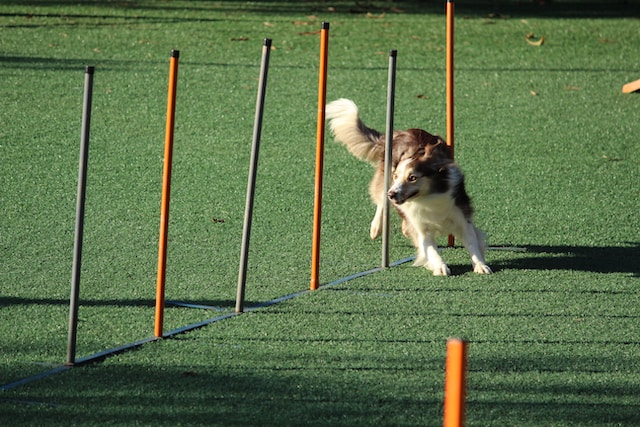The Benefits of Regular Exercise for Dogs Regular exercise is crucial for dogs to maintain a healthy weight, build strong muscles and bones, and prevent health issues such as diabetes and heart disease. Exercise also helps to reduce stress and anxiety in dogs and can improve their mood and overall behavior. Additionally, exercise provides mental stimulation, which is essential for a dog’s cognitive development and can help prevent boredom and destructive behavior. It’s important to note that the amount and type of exercise needed for each dog may vary based on their age, breed, and health condition. Consult with a veterinarian to develop an exercise plan that’s appropriate for your dog’s individual needs. Overall, incorporating regular exercise into your dog’s routine is a vital component of responsible pet ownership that can lead to a happier and healthier life for your furry friend.
Helps Control Weight
Similar to humans, obesity in dogs is becoming an increasingly prevalent concern. Overfeeding and lack of exercise can contribute to weight gain, which may result in health issues such as joint problems, heart disease, and diabetes. Implementing regular physical activity can assist in preventing obesity and maintaining your dog’s healthy weight. By promoting regular exercise, you can help your furry friend stay in optimal health and prevent any potential health issues from developing. Consulting with a veterinarian can provide you with further insight into how to incorporate exercise into your dog’s lifestyle appropriately.
Improves Mental Health
Providing mental stimulation for dogs is as important as physical activity. Regular exercise helps to keep dogs physically fit, while mental stimulation can prevent destructive behavior such as digging and chewing. It also helps to alleviate symptoms of anxiety and depression, making for a happier, more contented pet. Activities such as puzzle toys, interactive games, and obedience training challenge your dog’s mind, prevent boredom and strengthen the bond between you and your pet. Incorporating both physical and mental stimulation into your dog’s daily routine is vital to ensuring they lead a healthy, fulfilling life.
Strengthens Muscles and Bones
Keeping your dog active is essential for maintaining healthy muscles and bones, similar to humans. Regular exercise can help to prevent muscle loss, enhance muscle tone, and increase bone density. These benefits are especially crucial in aging dogs as they are more prone to experiencing muscle and bone loss. By ensuring that your furry friend gets enough physical activity, you can help to maintain their muscle and bone health, thereby improving their mobility and overall quality of life. A veterinarian can help you design an appropriate exercise plan for your dog based on their age, breed, and overall health status.
Promotes Socialization
Engaging your dog in regular exercise is a great way to encourage socialization. Taking your dog for walks, runs, or outings to dog parks allows them to interact with other dogs and people, which can help prevent behavioral issues like aggression and fear. Regular socialization through exercise can help your dog become more confident and comfortable around others, both human and canine, which is essential for their overall well-being. It’s important to supervise your dog during these interactions to ensure their safety and to make sure that they are not exhibiting any negative behaviors. Overall, exercise can be a fun and beneficial way to help your furry companion become a well-adjusted and sociable member of society.
Increases Lifespan
Research has demonstrated that regular exercise can prolong the lifespan of dogs. According to studies, dogs that engage in physical activity live longer than those who do not. This can be attributed to the various health benefits associated with exercise, such as better cardiovascular health and weight control. By incorporating physical activity into your dog’s daily routine, you can help to improve their overall health and increase their lifespan. However, it’s important to tailor the exercise routine to your dog’s needs and abilities to avoid any potential injury or strain. By consulting with a veterinarian, you can create an exercise plan that is safe and beneficial for your furry friend.
How Much Exercise Does My Dog Need?
Determining the appropriate amount of exercise for your dog depends on several factors, including their age, breed, and size. As a general guideline, dogs typically require 30 minutes to 2 hours of physical activity per day. It’s crucial to offer your dog a range of activities to keep them interested and stimulated. Variety in exercise routines can prevent boredom and encourage regular participation. Based on your dog’s specific needs, you can customize their exercise plan to include activities such as walks, runs, playtime, and training sessions. By providing your dog with the appropriate amount and type of physical activity, you can help to ensure their health, happiness, and overall well-being.
Some great exercise options for dogs include:
- Walking or running
- Playing fetch
- Swimming
- Agility training
- Playing with other dogs
Conclusion
Incorporating regular exercise into your dog’s routine is essential for maintaining their overall health and well-being. Engaging in physical activity can aid in weight management, enhance mental health, promote socialization, and increase the lifespan of your furry friend. By prioritizing regular exercise, you can help guarantee that your dog lives a long, healthy, and fulfilling life. A veterinarian can provide you with further guidance on how to develop an appropriate exercise regimen for your dog based on their age, breed, and health status. Ultimately, by prioritizing exercise, you can provide your dog with a high-quality life filled with activity and vitality.
